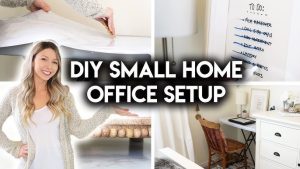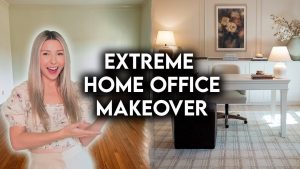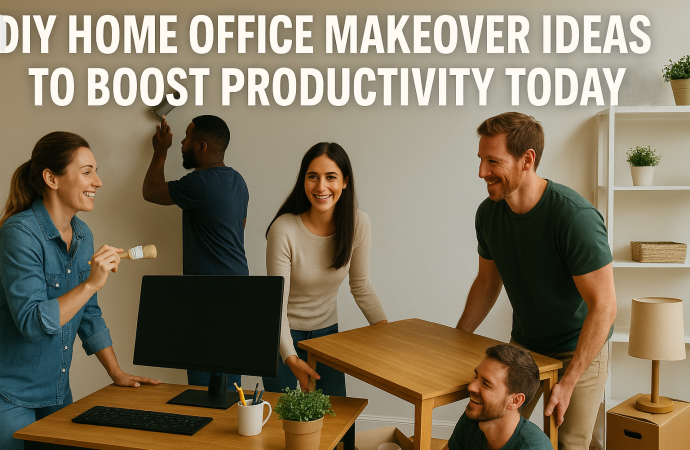Introduction Working from home has become the norm for many. Yet a cluttered, uninspiring workspace can hurt your focus and energy. With simple DIY home office makeover ideas, you can revamp your office to boost home office productivity today. This guide shares easy, budget-friendly tips—from creating an ergonomic workspace to adding personal touches. Whether you
Introduction
Working from home has become the norm for many. Yet a cluttered, uninspiring workspace can hurt your focus and energy. With simple DIY home office makeover ideas, you can revamp your office to boost home office productivity today. This guide shares easy, budget-friendly tips—from creating an ergonomic workspace to adding personal touches. Whether you have a spare room, living room or a small nook, our office makeover ideas help you design a space that fuels creativity, reduces stress, and keeps you on task. Get ready to transform your workday with a few simple changes.
What Is a DIY Home Office Makeover?

Image by: Yandex.com
A DIY home office makeover means updating your workspace using affordable, do-it-yourself projects. It covers painting, furniture upgrades, lighting improvements, and organization hacks. The goal is to create an environment that supports focus, comfort, and creativity. Unlike hiring a designer, DIY lets you tailor every detail to your needs and taste. This hands-on approach not only saves money but also gives you a sense of pride and ownership over your workspace. By following small, step-by-step office makeover ideas, you can achieve big results without major expense or time.
Why Boosting Home Office Productivity Matters

Image by: Yandex.com
Your workspace affects how you feel and perform. A well-designed office reduces distractions, improves posture, and stimulates your mind. Enhanced home office productivity means finishing tasks faster, with fewer breaks and less fatigue. This balance translates to better work-life balance, lower stress, and more free time and increased productivity. Investing in a DIY makeover pays off in higher motivation, improved health, and greater success in remote work. A few thoughtful changes can make your office a place you enjoy—and where productivity comes naturally.
Planning Your Office Makeover: Key Considerations
Before you start, assess your space and needs. Ask:
- What tasks do I perform most? Writing, calls, or creative work?
- How much space do I have? A large room or a small corner?
- What’s my budget? A simple refresh or a major overhaul?
- Which colors and styles inspire me? Calm neutrals or vibrant hues?
Sketch a floor plan. Note electrical outlets, natural light sources, and traffic flow. Identify pain points—too much clutter, poor lighting, or uncomfortable seating. With a clear plan, you choose the right office organization tips and design elements to create a cohesive, productive space.
Top DIY Home Office Makeover Ideas to Boost Productivity

Image by: Yandex.com
1. Step: Creating an Ergonomic Workspace
An ergonomic workspace protects your body and boosts focus. Start with desk and chair height:
- Desk should allow elbows at 90 degrees when typing.
- Chair height lets feet rest flat with knees at 90 degrees.
- Use a footrest if your chair is too high.
Position your monitor so the top sits at or just below eye level, about an arm’s length away. For laptops, use a stand plus an external keyboard and mouse. This setup prevents neck strain and repetitive stress injuries.
Add a wrist rest for typing and a back cushion if needed. A standing desk or desk converter lets you shift positions throughout the day. Alternate sitting and standing every 30–60 minutes to improve circulation and reduce fatigue.
2. Step: Optimizing Lighting for Focus
Lighting transforms any small space office. Poor light strains eyes and kills energy. Use a mix of ambient, task, and accent lighting:
- Ambient Light: Overhead fixtures or a central lamp that brightens the room.
- Task Light: A desk lamp with adjustable brightness for reading, writing, or computer work.
- Accent Light: LED strips or small spotlights to highlight artwork or shelves.
Place your desk near a window for natural light, but avoid glare on screens. Use sheer curtains to diffuse harsh sun. Choose bulbs with daylight color temperature (5000–6500K) to mimic natural light and keep you alert. Dimmable lights help shift mood from focused work to relaxed brainstorming.
3. Step: Clever Storage and Organization Tips
Clutter kills productivity. Good office organization tips: keep essential items close and hide the rest. Use vertical space:
- Install floating shelves for books and decor.
- Add pegboards for tools, cables, and stationery.
- Use wall-mounted bins for mail and notes.
- Under-desk storage Rolling carts or small cabinets hold files and supplies. Drawer organizers separate pens, paper clips, and sticky notes. Label boxes and folders for quick retrieval.
A simple rule: if you haven’t used it in three months, store it elsewhere or discard it. Keep only daily-use items on your desk. A tidy workspace reduces visual distractions and speeds up task completion.
4. Step: Adding Personal Touches for Inspiration
An inspiring small space office feels like your own sanctuary. Add personal touches that spark joy and creativity:
- Hang motivational prints or vision boards above your desk.
- Display photos of family, friends, or travel memories.
- Include indoor plants for color, air purification, and stress relief.
- Use decorative items, artwork, figurines, or colorful stationery—that reflect your style.
Switch these elements seasonally or monthly to keep your environment fresh. A few meaningful items can lift your mood and remind you why you work hard every day.
5. Step: Tech Upgrades for Efficiency
Keeping your tech up to date supports office makeover ideas:
- Cable Management: Use clips and sleeves to bundle cords. Label each cable with tags or colored ties.
- Wireless Accessories: Switch to a wireless keyboard, mouse, and headset to free desk space.
- Docking Stations: A USB-C dock connects laptop, monitor, and peripherals with one cable.
- Fast Wi-Fi: Upgrade your router or use mesh systems for stable, high-speed connections.
- Monitor Arms: Adjustable arms free desk space and allow custom monitor positions.
- Organize your digital desktop too: use folders, clear icons, and streamlined toolbars so you find files quickly. Regularly delete or archive old documents.
6. Step: Color Schemes and Decor for Productivity
Colors influence mood and focus. Choose a palette that suits your work:
- Blue and Green: Calming and focus-enhancing, ideal for analytical tasks.
- Yellow and Orange: Energizing and creative, great for brainstorming.
- Neutral Tones: Whites, grays, and beiges for a clean, minimalist look.
Paint an accent wall or use removable wallpaper behind your desk. Incorporate textures wood grains, woven baskets, or metal accents—for visual interest. Swap pillows or rugs to match your color scheme. Thoughtful decor elevates your space without cluttering it.
7. Step: Sound Control and Acoustics
Noise is a major distraction. Improve home office productivity with sound control:
- Add a rug or carpet to absorb echoes.
- Hang fabric wall art or tapestries for sound dampening.
- Use noise-canceling headphones to block external sounds.
- Play gentle background music or white noise for focus.
If possible, install a door sweep or acoustic panels on walls. A quiet environment lets you concentrate deeply and reduces stress.
8. Step: Routine Refresh and Maintenance
A great makeover is just the start. Maintain your space:
- Set a weekly 10-minute tidy-up routine for desk, cables, and floors.
- Dust and wipe surfaces monthly.
- Revisit your layout every quarter—swap items, update decor, or adjust lighting.
- Adjust your ergonomic workspace with new chair cushions or desk heights as needed.
Keeping your office fresh inspires ongoing motivation and prevents clutter from creeping back in.
Future Trends in Home Office Design

Image by: Yandex.com
Looking ahead, home offices will blend style with smart tech. Expect desks with built-in wireless chargers and desks that adjust height at the press of a button. Virtual reality corners might let you escape into focused “work worlds” for deep tasks. Sustainable materials—like bamboo desks and recycled fabric chairs will become more common. Modular systems that snap together easily will keep offices flexible for changing needs. As technology and design evolve, your DIY office will stay fresh and ready for any work challenge.
Comparative Table: Room Size vs. Office Makeover Tips
| Room Size | Key Challenge | Top Makeover Tips |
|---|---|---|
| Under 50 sq ft | Limited furniture | Foldable desk, wall shelves, declutter |
| 50–100 sq ft | Tight layout | L-shaped desk, multifunctional pieces |
| Over 100 sq ft | Empty space | Zoned areas, cozy reading nook |
Conclusion
A DIY home office makeover transforms your work environment into a productivity powerhouse. By creating an ergonomic home office with ideas for workspace, optimizing lighting, and using smart office organization tips, you set the stage for focus and efficiency to encourage productivity. Personal touches, tech upgrades, and sound control add comfort and inspiration. Match ideas to your small-space office constraints and revisit routines to keep your space fresh. These office makeover ideas help you work smarter and feel better each day.
















